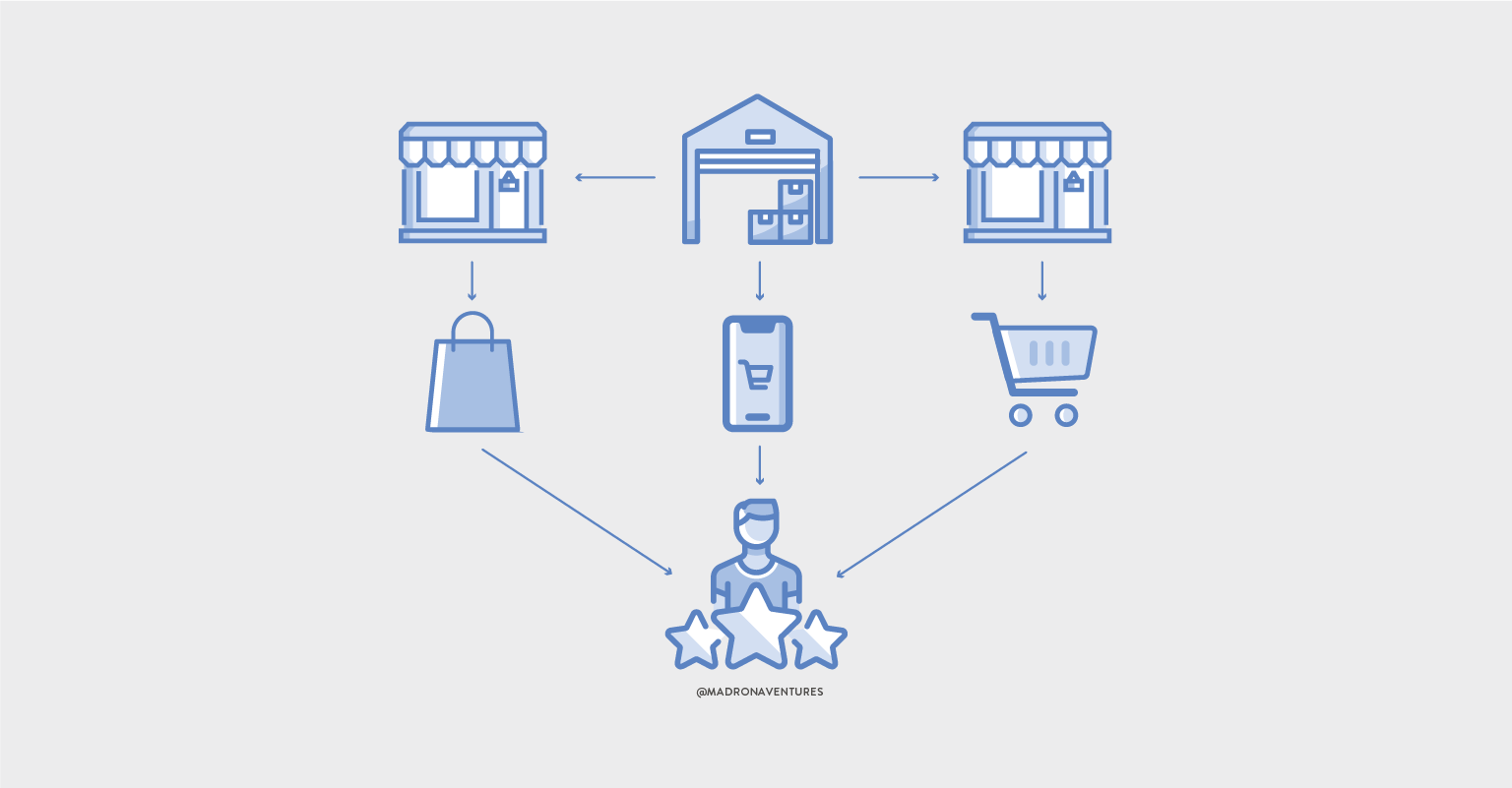This is the fourth and last deep dive into the technology investment themes we outlined earlier this year that we will delve into in 2019 and beyond.
Twenty-five years after the launch of Amazon.com, e-commerce represents about 10% of all retail sales. From zero to ten percent of a multi-trillion dollar sector in just 25 years is astronomical growth, but as convenient as shopping on the internet has become, it’s notable that nine out of ten transactions still take place offline. And yet, as we marvel at the pace of change and innovation in e-commerce over the last two and a half decades, the technological advancements in the physical retail experience are far less notable. In Seattle, we are at the center of much of this change and innovation, and while e-commerce and digital marketplaces remain a core investment theme at Madrona, we see a tidal wave of change coming to the physical retail world, led by technology, and are excited about several trends that will shape the future of physical retail.
“As we marvel at the pace of change and innovation in e-commerce over the last two and a half decades, the technological advancements in the physical retail experience are far less notable.”
Retail Infrastructure as a Service
For digitally native brands that can open an e-commerce store by launching a website or pushing an app to iTunes, opening a retail store feels like a trip to the stone ages. Hiring brokers, committing to long-term leases, spending hundreds of thousands of dollars on build-outs and inventory, hiring and training teams, and driving local awareness . . . a lot goes into it.
Indochino, a Madrona portfolio company and digitally native brand that sells custom clothing, now has 40 retail stores in North America. These stores generate a significant portion of the company’s revenue and are its best customer acquisition vehicle. New customers who engage with the brand through Indochino’s retail stores have a better first-time experience – they get fitted for their custom garments by a professional, they can touch and feel the fabrics, and they get guidance and advice to help them make their custom suits, shirts, and khakis truly their own. Indochino’s online business is growing fastest in markets where it has physical retail presence. But as successful as Indochino’s retail strategy has been, the process of finding, securing, and opening new stores is a grind. And opening dedicated stores like Indochino won’t be the right answer for all brands.
“We believe there is an opportunity to create retail ‘infrastructure as a service’ that is loosely analogous to the cloud IaaS we are all familiar with today.”
We believe there is an opportunity to create retail ‘infrastructure as a service’ that is loosely analogous to the cloud IaaS we are all familiar with today. Like their digital counterparts, retail IaaS providers will offer a mix of pure infrastructure, paid for on a usage basis (without long-term commitments), and value-added applications on top of the infrastructure.
For example, when establishing a physical retail presence in a market, a brand will be able to rent a whole retail space, open a shop-in-shop, or lease shelf space next to related brands in a store. The IaaS provider will take care of fixturing, IT, point of sale systems, and other infrastructure necessary to support the brand’s retail business, all built into the monthly price. Brands will be able to staff stores and/or sections with their own dedicated employees (hired and trained by the IaaS platform provider) or can rent partial time from the IaaS’s shared labor.
The platform provider will provide a range of value-added services back to brands (available a la carte), including store and shopper analytics, sales and inventory forecasting returns and exchange management (including for the brands’ online orders), and a host of local promotional services.
As far out there as this might sound, there are already a number of early-stage companies that have launched to address aspects of this opportunity, including Leap, FourPost, Showfields, and b8ta. We are following these companies and keeping our eyes open for new entrants that are meeting the needs of digitally native brands.
Digitizing the In-Store Experience
Nearly every aspect of the in-store retail experience can be improved by technology, whether applied in a clean-sheet (new retail format) context or retro-fitted onto existing retail stores. We are actively looking at and interested in opportunities across a few key areas of the retail experience, including:
- Frictionless Checkout Nobody likes to stand in line at the end of their shopping experience to pay. The magic of frictionless checkout at Amazon Go, Bingobox in China, and other similar concepts, is pushing retail incumbents to raise the bar on the payments experience in their retail locations. Startups like Zippin, Standard Cognition, AVA Retail and larger companies alike are racing to bring sensor fusion, machine learning, and human-in-the-loop reviews to quickly and accurately identify the items you’ve selected while shopping and automatically charge you for them within minutes of leaving the store. Other approaches to frictionless checkout (e.g., mobile, scanner-driven self-checkout) will get earlier traction in big box retail environments but are less defensible and represent a smaller long-term opportunity.
- Inventory Awareness and Prediction As retail stores become micro-warehouses and items on store shelves can be picked by the end consumer, by third-party delivery agents, and by the retailer’s own employees (for in-store pickup, online order fulfillment, or delivery), understanding quantity and state of inventory in a store becomes more complicated and more important. Systems have been developed to enable e-commerce fulfillment centers to track real-time location and state of inventory; something similar and yet more sophisticated must be developed for physical retail.
- Merchandising (compliance) The growth of Amazon’s multi-billion dollar advertising business is a reminder that brands spend massive marketing budgets to convert sell-in to sell-through and deploy a large chunk of these budgets to promotions at retail. Premium shelf placement, endcaps, and other marketing vehicles drive consumer awareness and demand; brands pay for placement, but at the store level, they don’t know whether their products are merchandised appropriately or have sufficient stock on the floor. There are some relatively mature companies addressing this in a manual way and some early-stage companies experimenting with robotics and automation to enable scale and precision. The size of the prize for vendors in this market remains an open question, but the potential value of instrumenting retail stores to provide the real-time visibility we take for granted on the internet is quite large.
- Customer Analytics The insights we capture about an online shopper (what channel drove them to the site, the products they viewed, the searches they executed, the items they added to cart, etc.) mostly don’t exist in physical retail. This is another category in which sensor fusion and machine learning could bring the offline experience to parity with its online counterpart. While some journalists and analysts have expressed concern about privacy in the context of ubiquitous camera coverage in retail stores, what we can learn about individual customer behavior at retail is already well-understood about those customers online. The frictionless checkout technology providers may be best positioned to provide the customer analytics, but there may also be opportunities for analytics companies to bolt onto the sensor infrastructure to provide deeper insights.
Faster Omni-Channel Delivery
The bright line between digital and physical commerce is blurring in large part due to innovations in supply chain and logistics. As physical retail stores perform double-duty as micro-fulfillment centers, and as Amazon and its scale competitors build ‘forward-deployed’ warehouses in major cities, same- and next-day delivery will be commonplace for orders placed through mobile, voice and in-person interfaces. This will require all omni-channel retail players to leverage technology and infrastructure to enable the near-instant gratification their customers will demand while doing so in a cost-effective manner. Technology areas we are actively tracking and/or pursuing that will be enablers of this future include:
- Virtual warehouse and fulfillment networks Companies like Flexe and Deliverr are building national networks of 3PLs with an intelligence and orchestration layer on top, enabling brands to store inventory near pockets of demand, enabling fast, cost-effective delivery SLAs that can match Amazon Prime (2-day delivery) in the near-term and same-day as these companies build out their networks and customer density. There are a handful of other companies building out their own 3PL infrastructure (versus serving as an orchestration layer on top), which we believe will enable tighter end-to-end control, but may prove prohibitive to scale.
- Last-mile (autonomous) robotic delivery At least half a dozen venture-backed companies (marble, nuro, starship technologies, Robby technologies, Dispatch, and unsupervised.ai) are piloting last-mile, robotic delivery solutions with local food and grocery delivery services. Amazon announced its own robotic delivery program, Scout, and both Wal Mart and FedEx are experimenting in this space. With last mile accounting for >50% of total fulfillment cost, mostly derived from fuel and labor, autonomous, ground-based robots could drastically improve the cost-effectiveness of same-day delivery.
“The bright line between digital and physical commerce is blurring in large part due to innovations in supply chain and logistics.”
Clean-Sheet Retail Concepts
In China, we’ve seen a spate of new retail concepts, from Bingobox, the unmanned convenience store, to Hema, Alibaba’s grocery store of the future, to Luckin, the mobile-first, delivery-oriented coffee chain. These concepts, built on top of the payments/messaging platforms of Alibaba and Tencent (and often leveraging their balance sheets), are growing at a pace unheard of in the U.S. They are leveraging many of the technologies discussed above and others to reimagine the retail customer experience.
Why don’t we see a similar pace of innovation and application of technology to reimagine the retail concept in the U.S.? Arguably, Amazon is leading the way with its Go stores (and to an extent the Bookstores and 4-Star); and we have seen some innovation from startups, mostly in the food/restaurant space, leveraging robotics (e.g., Zume Pizza, Spyce). But we have not seen the breadth and pace of retail innovation like we have in China. While capital-intensive, we believe these types of opportunities will exist in a number of retail categories, and we are starting to explore some early concepts with former executives who helped build the current generation of retail giants like Starbucks, Nordstrom, and REI, and who have made Seattle their home.
If you are working on one of these or related areas, and would like to trade thoughts and ideas and enrich the conversation, and/or if you’re looking for a thought and capital partner to help build your business, we’d love to hear from you; especially if you want to build it in Seattle, home to the most innovative online and omni-channel commerce companies in the world.


